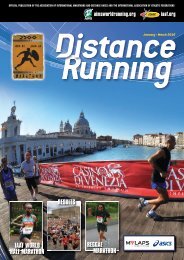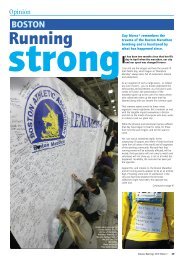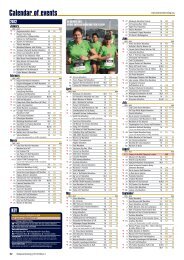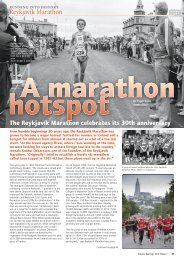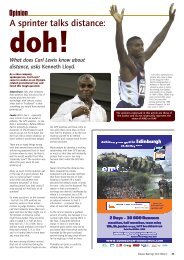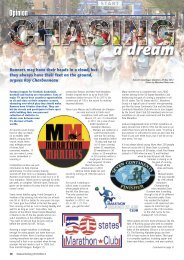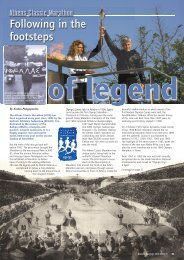Download pdf - Distance Running magazine
Download pdf - Distance Running magazine
Download pdf - Distance Running magazine
- No tags were found...
Create successful ePaper yourself
Turn your PDF publications into a flip-book with our unique Google optimized e-Paper software.
OPINIONStopping the clockPete Riegel argues that the time for allowing world roadrecords to be timed electronically has not yet comeBig-city mega-races are really twoseparate events. The elite fieldprovides the competitive sportsstory while the rest of the fieldgenerates publicity as acelebration of fitness camaraderieand charitable fundraising.Every race wants to set records, toshow that it is truly a major event.Because so much prestige andmoney are associated with arecord every effort is made toassure credibility through reliablemeasurement and timingprocedures.For mass runners timingstandards may be more relaxed.They want to see their finish timein the printed results, and areusually aware of roughly what itis. Typical finish line photos showrunners punching their watches asthey cross the line, although theyaccept a small difference in theofficially recorded time. Asidefrom individual runners’ desires tosee their own finish times there islittle interest in anything but whostopped the clock first.Timing winners has never beenmuch of a problem, but it is notpossible to hand-time everyfinisher to the same level ofaccuracy as the winner. When racefields grew to many thousands theold pull-tag and chute systemsbecame cumbersome andelectronic or “chip” timingsystems came into existence.ChampionChip is the most widelyused electronic system, althoughthere are others which employsimilar methods. They havebecome very effective inproducing fast and accurateresults. Timing road records isvery different, having evolved frommethods used on the track.At present, on the road and onthe track, the leading times aretaken when the runner’s torsobreaks the vertical plane of thefinish line. Three vetted timersindependently stop their watches.They compare the times, whichusually agree closely. If one ismarkedly different it is discardedas erroneous. Either way, thegreatest time is taken as officialand rounded up to the nearestwhole second.A fundamental difference betweenthe old and new systems is theprecise location of the timingpoints. In conventional timing theleading edge of the torso and thefinish line are clearly-definedpoints. In electronic timing thetorso is substituted by anelectronic chip carried by theEvery effort is made to assurecredibility through reliable measurementand timing procedures.runner and usually fastened toone shoe. The system is set up tocapture the time that the runner’schip-equipped foot crosses thefinish timing mat. The timingimpulse will occur somewhere onthe surface of the mat, close tobut not exactly coincident withthe finish line.Major races have been usingelectronic timing for over adecade, while the leading timeshave been captured separately byteams of human timers. Thesehand timings have been used asthe official times when recordshave been set. I have never seen acomparison between the two setsof times. This valuableinformation may have beenpreserved, but I am not aware thatit has been published.In the early days of electronictiming malfunctions sometimesoccurred. Indeed, in a field ofmany thousands it is almostcertain that a few times will bemissed, just as for hand timing.Perfection eludes us, but reasonsfor electronic mix-ups include:1 The runner forgets to wear their chip2 The chip is lost along the route3 The chip is worn on the vest instead ofthe shoe4 Roommates get their chips mixed up5 A runner cannot compete, and givesthe chip to another runner6 The chip impulse is missed by thereceiving system. This does not happenoften, but it does happen7 Cheaters bring many inventiveapproaches too numerous to mention8 The timing system itself suffers apartial or complete breakdown.Finish times should spring fromthe computer system to the publicas fast as runners cross the line.This can happen further down thefield but rarely for the topfinishers. There is always a shortdelay while human timing systemoperators scrutinize the leadingtimes to be sure that they makesense. Occasionally backup timesare inserted in place of missingelectronic times. The substitutionis done by the timing systemoperators unobserved by thepublic. The results become officialas published, and as far as mostare concerned, the electronicwizardry did its job.Given reasonable chances thatthings could go wrong, it wouldbe negligent to rely only onelectronic timing. The potentialfor embarrassment demandsreliable backup. Some systemshave built-in electronic backupwhich supposedly compensatesfor errors, but the most commonform, certainly for the leadfinishers, is human timers.Human timing as a backup hasobvious advantages. Most peoplefind no difficulty in understandinga human punching a watch. Whenthe processing flows through acomputer, with results sometimesadjusted by the timing supervisorthe outcome appears as if byblack magic.Anybody can understand threehumans punching their watches.The winner cannot bemisidentified. He or she is seenby all. And the time that results isthe one that meets the presentrecord standard. Given the hugebudgets of most big races it doesnot seem unreasonable to askthem to provide three people todo this relatively uncomplicatedjob of stopping the clock.Timing technology is changing,and for the better. When it can bedemonstrated that electronictimes are as accurate and reliableas three stopped watches perhapsthey can be used for records. Thattime has not yet come.The views expressed in thisarticle are those of theauthor and do notneccessarily represent theviews of AIMS or IAAFA fundamental difference betweenthe old and new systems is the precise locationof the timing points.DISTANCE RUNNING April – June 200665



